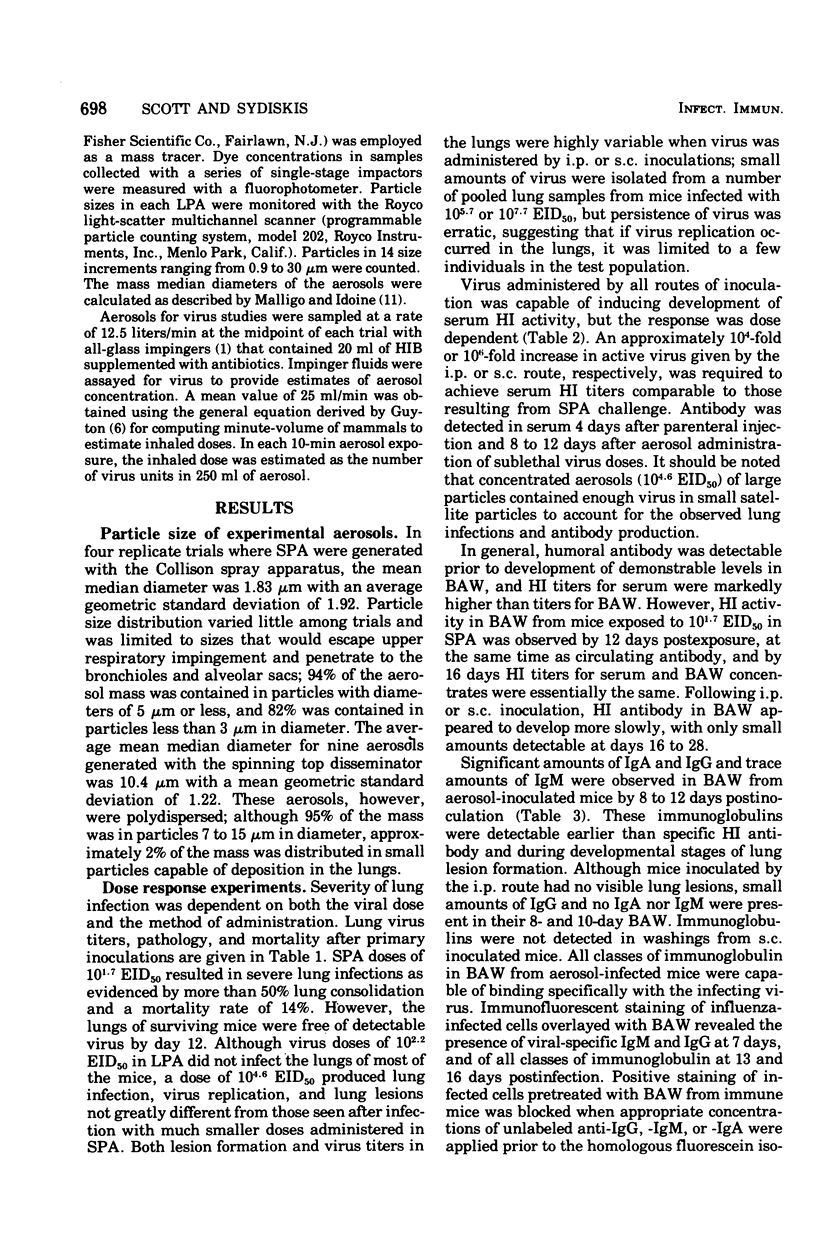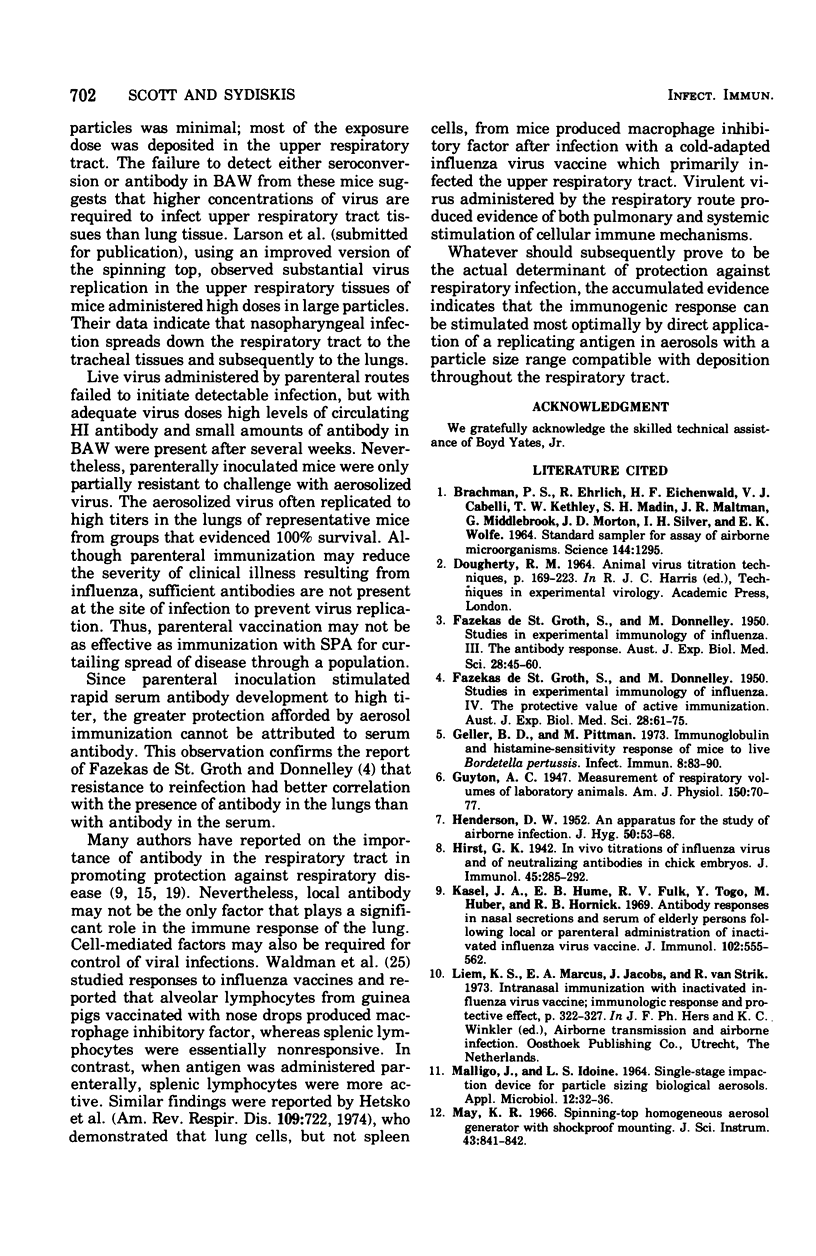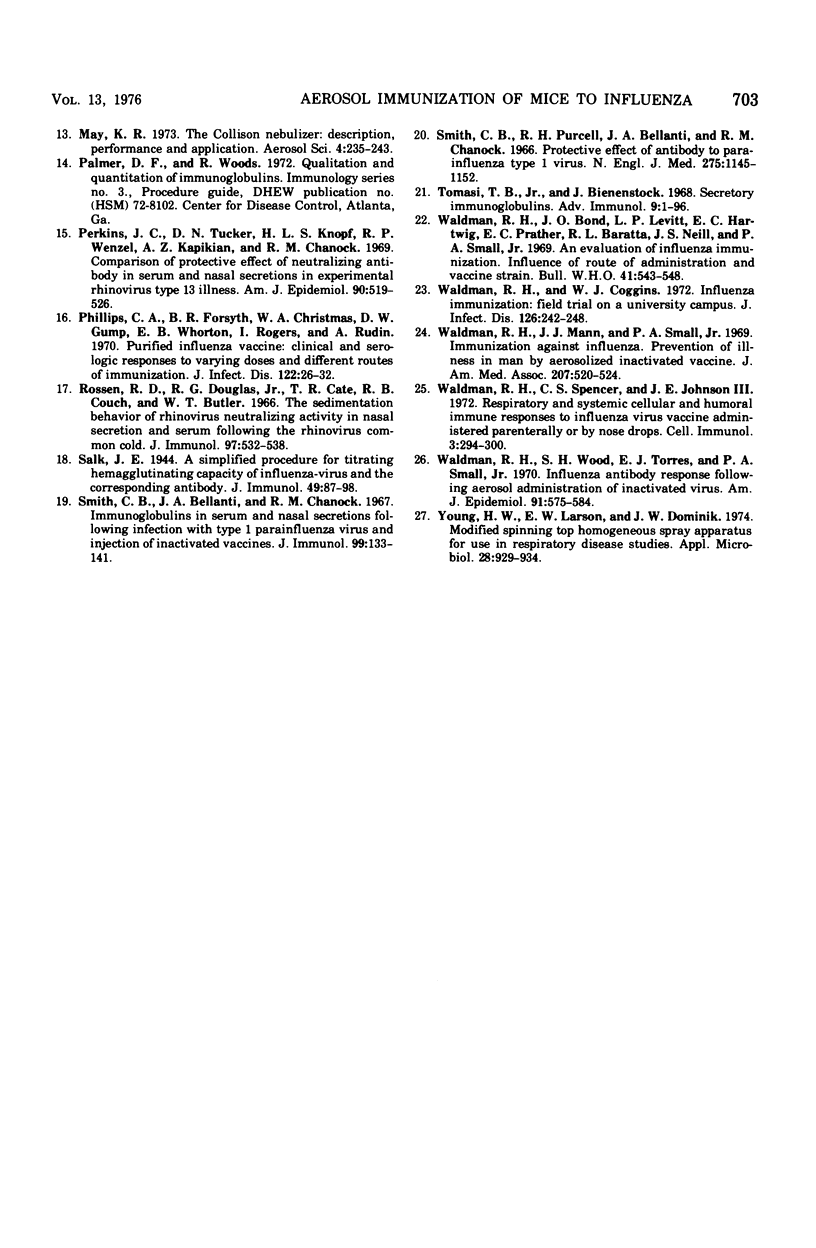Abstract
Antibody levels in sera and respiratory secretions and resistance to respiratory infections were examined in mice given live infuenza virus in small-particle (2 mum) aerosols, large-particle (10 mum) aerosols, intraperitoneally, and subcutaneously. After parenteral administration antibody was found primarily in the serum, but small amounts were recovered in bronchoalveolar washings after 2 to 3 weeks. Specific antibody was present in both sera and bronchoalveolar washings from mice given virus in small-particle aerosols to achieve virus dissemination throughout the respiratory tract. Immunoglobulin A, immunoglobulin G, and trace amounts of immunoglobulin M, all specific for the infecting virus, were detected in bronchoalveolar washings of small-particle aerosol-infected mice. Virus administration in large-particle aerosols (for primary virus localization in upper respiratory tract) at doses greater than those required to initiate infection with small-particle aerosols failed to stimulate production of antibody in sera or bronchoalveolar washings. Small-particle aerosol-immunized mice were resistant to subsequent challenge with 10(2.0) respiratory median lethal doses of virulent virus, whereas large-particle aerosol-immunized mice were not protected. Parenteral immunization modified the course of the disease in challenged mice and reduce mortality rates but did not prevent reinfection of the respiratory tract.
Full text
PDF







Selected References
These references are in PubMed. This may not be the complete list of references from this article.
- FAZEKAS de ST GROTH S., DONNELLEY M. Studies in experimental immunology of influenza. III. The antibody response. Aust J Exp Biol Med Sci. 1950 Jan;28(1):45–60. doi: 10.1038/icb.1950.4. [DOI] [PubMed] [Google Scholar]
- FAZEKAS de ST GROTH S., DONNELLEY M. Studies in experimental immunology of influenza. IV. The protective value of active immunization. Aust J Exp Biol Med Sci. 1950 Jan;28(1):61–75. doi: 10.1038/icb.1950.5. [DOI] [PubMed] [Google Scholar]
- Geller B. D., Pittman M. immunoglobulin and histamine-sensitivity response of mice to live Bordetella pertussis. Infect Immun. 1973 Jul;8(1):83–90. doi: 10.1128/iai.8.1.83-90.1973. [DOI] [PMC free article] [PubMed] [Google Scholar]
- HENDERSON D. W. An apparatus for the study of airborne infection. J Hyg (Lond) 1952 Mar;50(1):53–68. doi: 10.1017/s0022172400019422. [DOI] [PMC free article] [PubMed] [Google Scholar]
- Kasel J. A., Hume E. B., Fulk R. V., Togo Y., Huber M., Hornick R. B. Antibody responses in nasal secretions and serum of elderly persons following local or parenteral administration of inactivated influenza virus vaccine. J Immunol. 1969 Mar;102(3):555–562. [PubMed] [Google Scholar]
- MALLIGO J. E., IDOINE L. S. SINGLE-STAGE IMPACTION DEVICE FOR PARTICLE SIZING BIOLOGICAL AEROSOLS. Appl Microbiol. 1964 Jan;12:32–36. doi: 10.1128/am.12.1.32-36.1964. [DOI] [PMC free article] [PubMed] [Google Scholar]
- May K. R. Spinning-top homogeneous aerosol generator with shockproof mounting. J Sci Instrum. 1966 Nov;43(11):841–842. doi: 10.1088/0950-7671/43/11/418. [DOI] [PubMed] [Google Scholar]
- Perkins J. C., Tucker D. N., Knopf H. L., Wenzel R. P., Kapikian A. Z., Chanock R. M. Comparison of protective effect of neutralizing antibody in serum and nasal secretions in experimental rhinovirus type 13 illness. Am J Epidemiol. 1969 Dec;90(6):519–526. doi: 10.1093/oxfordjournals.aje.a121098. [DOI] [PubMed] [Google Scholar]
- Phillips C. A., Forsyth B. R., Christmas W. A., Gump D. W., Whorton E. B., Rogers I., Rudin A. Purified influenza vaccine: clinical and serologic responses to varying doses and different routes of immunization. J Infect Dis. 1970 Jul-Aug;122(1):26–32. doi: 10.1093/infdis/122.1-2.26. [DOI] [PubMed] [Google Scholar]
- Rossen R. D., Douglas G., Jr, Cate T. R., Couch R. B., Butler W. T. The sedimentation behavior of rhinovirus neutralizing activity in nasal secretion and serum following the rhinovirus common cold. J Immunol. 1966 Oct;97(4):532–538. [PubMed] [Google Scholar]
- Smith C. B., Bellanti J. A., Chanock R. M. Immunoglobulins in serum and nasal secretions following infection with type 1 parainfluenza virus and injection of inactivated vaccines. J Immunol. 1967 Jul;99(1):133–141. [PubMed] [Google Scholar]
- Smith C. B., Purcell R. H., Bellanti J. A., Chanock R. M. Protective effect of antibody to parainfluenza type 1 virus. N Engl J Med. 1966 Nov 24;275(21):1145–1152. doi: 10.1056/NEJM196611242752101. [DOI] [PubMed] [Google Scholar]
- Tomasi T. B., Jr, Bienenstock J. Secretory immunoglobulins. Adv Immunol. 1968;9:1–96. doi: 10.1016/s0065-2776(08)60441-1. [DOI] [PubMed] [Google Scholar]
- Waldman R. H., Bond J. O., Levitt L. P., Hartwig E. C., Prather E. C., Baratta R. L., Neill J. S., Small P. A., Jr An evaluation of influenza immunization: influence of route of administration and vaccine strain. Bull World Health Organ. 1969;41(3):543–548. [PMC free article] [PubMed] [Google Scholar]
- Waldman R. H., Coggins W. J. Influenza immunization: field trial on a university campus. J Infect Dis. 1972 Sep;126(3):242–248. doi: 10.1093/infdis/126.3.242. [DOI] [PubMed] [Google Scholar]
- Waldman R. H., Mann J. J., Small P. A., Jr Immunization against influenza. Prevention of illness in man by aerosolized inactivated vaccine. JAMA. 1969 Jan 20;207(3):520–524. doi: 10.1001/jama.207.3.520. [DOI] [PubMed] [Google Scholar]
- Waldman R. H., Spencer C. S., Johnson J. E., 3rd Respiratory and systemic cellular and humoral immune responses to influenza virus vaccine administered parenterally or by nose drops. Cell Immunol. 1972 Feb;3(2):294–300. doi: 10.1016/0008-8749(72)90168-2. [DOI] [PubMed] [Google Scholar]
- Young H. W., Larson E. W., Dominik J. W. Modified spinning top homogeneous spray apparatus for use in experimental respiratory disease studies. Appl Microbiol. 1974 Dec;28(6):929–934. doi: 10.1128/am.28.6.929-934.1974. [DOI] [PMC free article] [PubMed] [Google Scholar]


